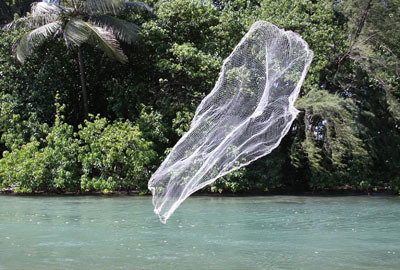Allora & Calzadilla
dal 3/9/2010 al 15/10/2010
Segnalato da
3/9/2010
Allora & Calzadilla
Galerie Chantal Crousel, Paris
Solo show

Galerie Chantal Crousel is pleased to announce its third exhibition with artists Jennifer Allora
and Guillermo Calzadilla. For this exhibition, the artists present five works organized around the
principle of physical and temporal displacement. Gathering material elements from different social,
geographical, and cultural systems into the field of a single image/form, the works presented here
use metaphor as a structuring and distributional force to expand the frame through which normal
circuits of meaning are determined. The artists likewise privilege the aberrant, excessive, and
disruptive workings of metaphors and other tropes to destabilize the functional stability of these
ordering structures.
Occupying the main space of the gallery floor is Scale of Justice Carried by Shore Foam, 2010, a
realistic hand crafted sculpture of shore foam, on top of which is positioned a readymade “Scale of
Justice” precariously out of balance atop the turbulent crest. This mass of bubbles of gas and air
is given permanent form through the use of synthetic polymer foam, a chemical substrate found in
everything from household, sport, and leisure products to transportation, industrial, and military
applications. The image of shore foam has come to occupy the public imaginary more prominently
in recent years as a result of countless media depictions of man made catastrophes from the oil spill
in the Gulf of Mexico to the now annual flooding worldwide caused by global warming. With these
ecological events cutting across national and territorial borders, the scale of justice has become an
object of explicit struggle. Presented here in sculptural form, this ephemeral froth stands as the
remains of something that has come to pass, frozen in time, with the final balance of the scale left
undetermined.
A Man Screaming is Not a Dancing Bear, 2008, sets the frame of ecological witness–bearing and
environmental justice within the traumatized landscape of post-Katrina New Orleans. The film
focuses on two scenes: the interior of a flooded house in the Lower Ninth Ward, the historically poor
predominately African American neighborhood that was completely destroyed by the failed levee
system, and the wetlands of the lower Mississippi River Delta out of which the city of New Orleans
was carved. The film depicts a resident of the Ninth Ward, Isaiah McCormick, “playing” a set of
window blinds in his house. The percussive rhythms he creates on this homegrown instrument - a
gesture that inevitably evokes the great musical experiments of the Mississippi - expose the home
interior to the light outdoors, generating an inconstant flutter of light that reveals the sediments,
marks and uneven traces left by the events of a recent history.
Processes of sedimentation are at work in Petrified Petrol Pump, 2010, an abandoned gasoline pump
that appears to have turned into stone. Made from fossil-filled limestone, the indexes of ancient
life forms that are visible throughout the sculptural body attest to the organic plentitude of the
earth’s pre-history, the very life forms whose long process of anaerobic decomposition provides the
material used today to generate energy.
The Camel’s Humps and the Ironing Board, 2010 is a hybrid assemblage consisting of the stuffed upper
hide of a Bactrian camel placed on top of a readymade ironing board. The camel’s humps, the part
of the animal’s anatomy where fatty deposits are stored and thus enable it to withstand extreme
temperature changes, are here radically disembodied. If the physics behind ironing is the
liquid-glass transition: when fabric is heated above the transition temperature of 100° Celsius
causing the fibers to become mobile so that the weight of the iron can impose onto them a preferred
orientation, then, in this sculptural scenario, the violently truncated appearance of the camel’s back
upon an ironing table, present a monstrous wrinkle, an ingenious trick whose peak shape imposes
a new orientation that reconvenes an image of landscape, domesticity, figure/ground and animal/
human relations.
Forecast, 2010, uses the photographic apparatus to present the precise moment of formal stasis in
the trajectory of a fishing net’s casting into the water, where the lift of flight and the pull of gravity
act equally upon its woven matrix of threads. The result is an amorphous shape that presents a
possible form to come as well as its simultaneous disappearance. The collection of vertices, edges,
and faces that define the shape of this polyhedral object form a temporary map across physical,
conceptual, and poetic domains.
Jennifer Allora (born 1974, USA) and Guillermo Calzadilla (born 1971, Cuba) have been collaborating
since 1995. They have been the subject of numerous solo exhibitions worldwide, including
presentations at Haus der Kunst and Kunstverein Munich; Stedelijk Museum, Amsterdam; San
Francisco Art Institute; Serpentine Gallery, London; Kunsthalle Zurich; and The Renaissance Society,
Chicago. They have also been included in group exhibitions such as “Prospect 1 New Orleans”; the
8th & 9th Lyon Biennales; Whitney Biennial 2006: Day for Night; 51st Venice Biennale; “Ailleurs/
Ici,” Musée d’Art Moderne de la Ville de Paris/ARC Paris, “How Latitudes Become Form,” Walker
Arts Center, Minneapolis, and “Common Wealth,” Tate Modern. Allora & Calzadilla are based in
San Juan, Puerto Rico.
Image: Jennifer Allora & Guillermo Calzadilla,Forecast, 2010, C-print, 105 x 70 cm
Opening on September 4th from 6pm to 9pm
Galerie Chantal Crousel
10 rue Charlot - Paris



